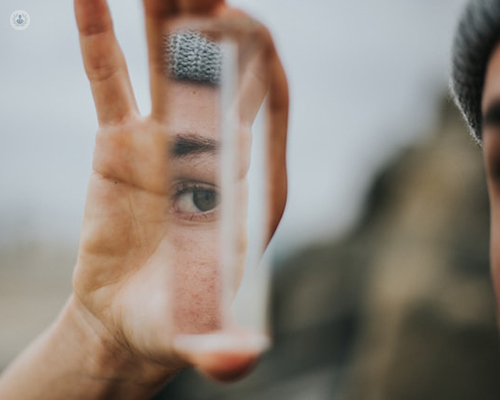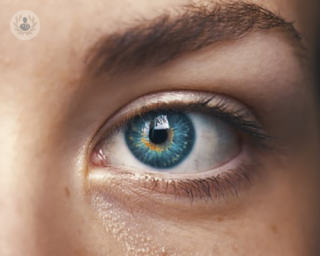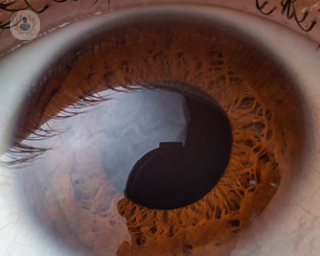Retinopathy
Miss Shahrnaz Izadi - Ophthalmology
Created on: 11-13-2012
Updated on: 09-15-2023
Edited by: Sophie Kennedy
What is retinopathy?
Retinopathy encompasses all non-inflammatory diseases affecting the retina. The most common are diabetic retinopathy, hypertensive retinopathy (a complication of hypertension) and retinitis pigmentosa. Diabetic retinopathy, a vascular complication of diabetes, is the most common type of retinopathy.
The retina is a thin layer of light-sensitive tissue made up of small blood vessels that covers the inner wall of the eye. Damage to the small blood vessels may lead to considerable and irreversible visual loss.
Diabetic retinopathy can affect all people with diabetes, whether it is Type 1 or Type 2. There are two types of diabetic retinopathy:
- Early or non-proliferative diabetic retinopathy: no new blood vessels are being formed and the damage is limited to the retina. As the vessels become obstructed over time, the retinopathy becomes more serious. Sometimes, the central part of the macula becomes inflamed (macular oedema).
- Advanced or proliferative diabetic retinopathy: the blood vessels close, leading to the formation of new abnormal vessels that may leak blood into the vitreous. The scar tissue that forms may lead to retinal detachment. If the new vessels interfere with flow, the eye pressure may rise, possibly leading to glaucoma.

Retinopathy has four stages:
- Mild non-proliferative retinopathy: the earliest stage of the disease in which micro-aneurysms appear.
- Moderate non-proliferative retinopathy: some blood vessels of the retina become obstructed as the disease progresses.
- Severe non-proliferative retinopathy: several vessels are blocked such that some parts of the retina do not receive blood.
- Proliferative retinopathy: the retina produces signals for the formation of new blood vessels. The new blood vessels are fragile and abnormal, growing along the length of the retina and the surface of the vitreous. When these vessels lose blood, severe visual loss or blindness may result.
Prognosis
Normally, the prognosis of retinopathy is favourable after treatment. When the hypertension is controlled, normal vision is restored and there are hardly any residual effects.
However, if the patient is not diagnosed in a timely manner, the disease progresses, becoming chronic hypertensive retinopathy, increasing the probability of visual loss. An early diagnosis is vital for treatment and cure of retinopathy.
Symptoms of retinopathy
Retinopathy is an asymptomatic disease in its early stages. As the disease progresses, symptoms such as the following may appear:
- Dark fibres or patches (floaters)
- Blurred vision
- Impaired colour vision
- Areas of darkness
- Variable vision
- Gradual loss of vision
- Difficulty reading
When liquid accumulates in the central area of the retina, it is called diabetic macular oedema and this is the leading cause of visual loss.
Testing for retinopathy
During diagnosis of retinopathy, the condition of the eye and the retina must be examined using optical coherence tomography (OCT) angiography, which is able to detect any pathology of the retina that can affect vision.
Angiography is combined with the following tests:
- Dilated eye examination: the pupils are dilated in order to examine the condition of the retina and the optic nerve.
- Visual acuity testing
- Angiography with fluorescein
- Slit-lamp examination
What are the causes of retinopathy?
Diabetes is a disease in which the body is not able to control the level of sugar in the blood. High blood sugar levels cause reactions that ultimately obstruct blood vessels, impeding blood flow.
There are two types of diabetes: type 1 and type 2.
- Type 1 diabetes: the patient’s body cannot produce its own insulin so an external source of insulin must be administered.
- Type 2 diabetes: the patient is considered insulin-resistant in that their body produces insulin but does not use it as it should. Blood insulin levels are higher than normal.

Can it be prevented?
This disease cannot always be prevented. However, regular eye examinations and control of blood pressure and blood sugar levels can help to prevent it.
If you have diabetes, you should bring your blood sugar levels, your cholesterol levels and your blood pressure under control, and give up harmful habits such as smoking.
In patients with diabetes, there are certain factors that increase the risk of retinopathy:
- Disease duration: the longer the disease duration, the higher the risk
- Poor control of blood sugar
- High blood pressure
- High cholesterol
- Pregnancy
- Smoking
- Asian or Afro-Caribbean backgrounds
Treatment of retinopathy
Treatment depends on the stage of the disease and its severity.
- Early diabetic retinopathy: at this stage, the patient may not need immediate treatment. The specialist will monitor the disease.
- Advanced diabetic retinopathy: in this case, immediate surgical treatment is required, given that proliferative diabetic retinopathy or oedema is present.
Types of treatment may include:
- Focal laser treatment: stops or slows down the leakage of blood or liquid into the eye
- Extensive later treatment: reduces abnormal blood vessels
- Vitrectomy: a small incision is made to remove blood from the vitreous and retinal scars.
Surgery slows down or stops the progression of the disease, but does not cure it.








